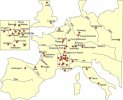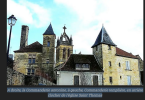The information board at the Ruins of San Antón states that the convent was founded in 1146 under the patronage of King Alfonso VII. The same sign says that the ruins are 14th century, while a large sign nearby used to say that they are 15th century [https://medium.com/a-walking-miracle/day-13-2-b82e5492a60 posted Dec 2020] A new large sign says they are 14th century (I was there in October this year). It seems odd to me that they can date the foundation to a precise year (1146), but provide no date for the building of the convent of which we now see the ruins – sometime in the 14th century – oops, sorry 15th century. Do you know when the convent was built, more or less?
The sign goes on to say that "The baroque altarpiece is preserved in the church of San Juan Bautista." Do you know how many churches in Spain are dedicated to San Juan Bautista? A lot, I bet. OK , it's probably the church of San Juan Bautista in Castrojeriz, but how much would it have cost to add the name of the town?
The sign goes on to say that "The baroque altarpiece is preserved in the church of San Juan Bautista." Do you know how many churches in Spain are dedicated to San Juan Bautista? A lot, I bet. OK , it's probably the church of San Juan Bautista in Castrojeriz, but how much would it have cost to add the name of the town?
























